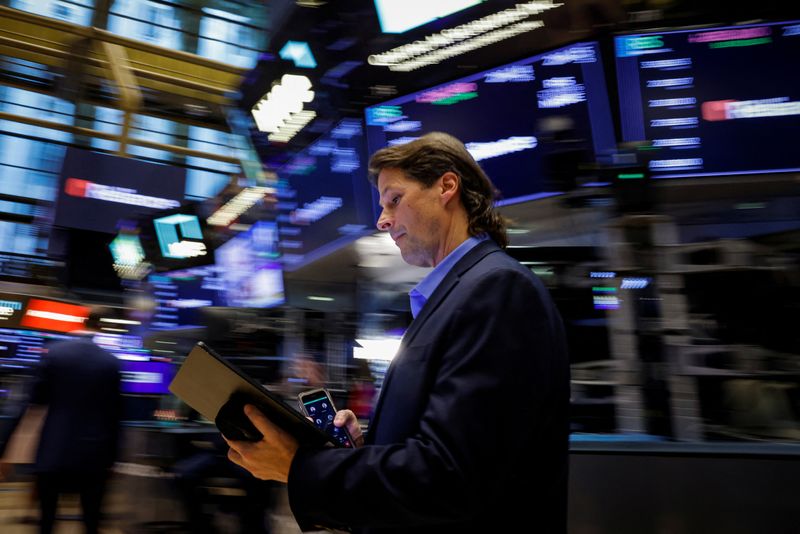Morning Bid: Dollar surges as European, Japan hawks coo
2024.10.03 06:14
A look at the day ahead in U.S. and global markets from Mike Dolan
The U.S. dollar is on course for its best week in six months, surging anew on Thursday against the yen, sterling, euro and Swiss franc as central banks around the world appear set to out-dove the Federal Reserve.
Partly spurred earlier this week by a “safety bid” surrounding Middle East tensions, dollar gains have really mounted as speculation of another round of interest rate cuts in Europe were twinned with official hesitation at further monetary tightening in Japan – with inflation subsiding everywhere.
And with U.S. labor market signals continuing to show brisk job creation, the relative rates picture seems to have shifted back in favor of the greenback – whose 1.5% appreciation this week is the biggest since April.
The Bank of England, a recent holdout in the rush to peg back interest rates, was the latest to turn decidedly dovish as BoE boss Andrew Bailey told the Guardian newspaper the central bank could become “a bit more activist” and “a bit more aggressive” in its approach to lowering rates.
With a second rate cut of year now fully priced for the BoE’s meeting next month, the pound dropped more than a cent on Thursday to three-week lows just above $1.31.
The tone has shifted across the European continent too.
Hawkish European Central Bank board member Isabel Schnabel underscored forecasts for another ECB rate cut in a fortnight’s time by saying on Wednesday: “A sustainable fall of inflation back to our 2% target in a timely manner is becoming more likely.”
And her ECB colleague Mario Centeno went one further: “Now we face a new risk: undershooting target inflation, which could stifle economic growth,” he said.
European September business surveys on Thursday confirmed the bloc’s private sector activity slipped back into contraction last month.
A rapid disinflation scenario was obvious again in Switzerland, which saw monthly deflation on 0.3% last month that dragged annual inflation to as low as 0.8% – well below forecast and increasing pressure on the Swiss National Bank to ease again even with rate there back as low as 1% already.
In his first public appearance since taking charge, new chairman Martin Schlegel on Tuesday also said the SNB was not ruling out taking interest rates into negative territory.
Over in Asia, it appears the Bank of Japan’s moves to ‘normalize’ its ultra-low policy rates have also been stopped in their tracks and the yen fell to its weakest in six weeks through 147 per dollar.
Japanese Prime Minister Shigeru Ishiba completed a backflip from perceived monetary hawk to dove on Wednesday by saying: “I do not believe that we are in an environment that would require us to raise interest rates further.”
BOJ policymaker Asahi Noguchi, who dissented against a rate hike in July, doubled down on Thursday by saying the central bank must be patient in normalizing policy.
The sudden concern around the world about ebbing inflation is partly down to plummeting oil prices – which despite a modest pop on the Israel/Iran standoff this week are still clocking annual losses of more than 20% and have been for more than a month.
An OPEC+ meeting on Wednesday did little to offset that, with ministers keeping policy unchanged and including a plan to start raising output from December. And the latest week’s data showed oil and gasoline inventories rising.
By contrast with Europe, Fed easing hopes cooled somewhat as this week’s stream of employment statistics underlined the ‘soft landing’ thesis there, taking some more heat out of rate cut bets.
Private payrolls increased by 143,000 jobs last month after rising by an upwardly revised 103,000 in August, the ADP National Employment Report showed on Wednesday. September updates on layoffs and weekly jobless claims are due later on Thursday alongside updated service sector surveys for last month.
Richmond Federal Reserve President Thomas Barkin told Reuters on Wednesday he was still concerned about the “last mile” in getting inflation back to target. “I’m more concerned about inflation than I am about the labor market,” he said about the outlook through next year.
The upshot was futures pricing for Fed rate cuts through the end of this year ebbing back below 70 basis points and Treasury yields nudging higher, with the 10-year nosing back above 3.80%.
Stock markets around the world were more mixed, with European stocks in the red on Thursday and Hong Kong stocks taking their first step back since China’s frenetic stimulus measures were unveiled last week.
outperformed with gains of almost 2% on the BOJ soundings and weakening yen.
With Wall St stocks flat on Wednesday, held back by disappointing deliveries readings from automaker Tesla (NASDAQ:), index futures were slightly in the red ahead of Thursday’s open.
Emboldened by “soft landing” hopes, U.S. high-yield junk bond yield spreads over Treasuries have fallen close to their lowest for the year and are testing historic lows on an options-adjusted basis.
With the third quarter earnings season about to unfold and parsing a final quarter of political nerves from the Middle East to the U.S. election, the volatility gauge is above historical averages and hovering just shy of 20.
Key developments that should provide more direction to U.S. markets later on Thursday:
* US September Challenger layoffs, weekly jobless claims, September service sector surveys from ISM and S&P Global, August factory goods orders
* Atlanta Federal Reserve President Raphael Bostic and Minneapolis Fed President Neel Kashkari both speak

* US corporate earnings: Constellation Brands (NYSE:), AngioDynamics (NASDAQ:)
* US Treasury auctions 4-week bills
(By Mike Dolan, editing by Mark Heinrich; mike.dolan@thomsonreuters.com)








